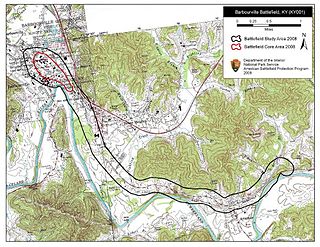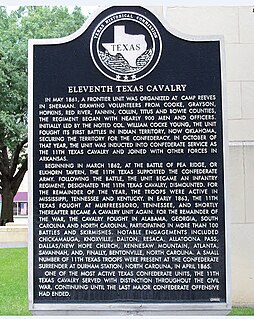Related Research Articles

Braxton Bragg was an American army officer during the Second Seminole War and Mexican–American War and Confederate army officer who served as a general in the Confederate Army during the American Civil War, serving in the Western Theater. His most important role was as commander of the Army of Mississippi, later renamed the Army of Tennessee, from June 1862 until December 1863.

Appalachia is a cultural region in the Eastern United States that stretches from the Southern Tier of New York State to northern Alabama and Georgia. While the Appalachian Mountains stretch from Belle Isle in Canada to Cheaha Mountain in Alabama, Appalachia typically refers only to the cultural region of the central and southern portions of the range, from the Blue Ridge Mountains of Virginia southwest to the Great Smoky Mountains. As of the 2010 United States Census, the region was home to approximately 25 million people.

The Battle of Perryville, also known as the Battle of Chaplin Hills, was fought on October 8, 1862, in the Chaplin Hills west of Perryville, Kentucky, as the culmination of the Confederate Heartland Offensive during the American Civil War. Confederate Gen. Braxton Bragg's Army of Mississippi initially won a tactical victory against primarily a single corps of Maj. Gen. Don Carlos Buell's Union Army of the Ohio. The battle is considered a strategic Union victory, sometimes called the Battle for Kentucky, since Bragg withdrew to Tennessee soon thereafter. The Union retained control of the critical border state of Kentucky for the remainder of the war.

Lieutenant-General Leonidas Polk was a bishop of the Episcopal Diocese of Louisiana and founder of the Protestant Episcopal Church in the Confederate States of America, which separated from the Episcopal Church of the United States of America. He was a slaveholding planter in Maury County, Tennessee, and a second cousin of President James K. Polk. He resigned his ecclesiastical position to become a major-general in the Confederate States Army, when he was called "Sewanee's Fighting Bishop". His official portrait at the University of the South depicts him dressed as a bishop with his army uniform hanging nearby. He is often erroneously referred to as "Leonidas K. Polk," but he had no middle name and never signed any documents as such.
The Army of the Ohio was the name of two Union armies in the American Civil War. The first army became the Army of the Cumberland and the second army was created in 1863.

The Western Theater of the American Civil War encompassed major military operations in the states of Alabama, Georgia, Florida, Mississippi, North Carolina, Kentucky, South Carolina and Tennessee, as well as Louisiana east of the Mississippi River. Operations on the coasts of these states, except for Mobile Bay, are considered part of the Lower Seaboard Theater. Most other operations east of the Appalachian Mountains are part of the Eastern Theater. Operations west of the Mississippi River took place in the Trans-Mississippi Theater.

The Battle of Barbourville was one of the early engagements of the American Civil War. It took place on September 19, 1861, in Knox County, Kentucky during the campaign known as the Kentucky Confederate Offensive. The battle is considered the first Confederate victory in the commonwealth, and threw a scare into Federal commanders, who rushed troops to central Kentucky to try to repel the invasion, which was finally stopped at the Battle of Camp Wildcat in October.

Perryville Battlefield State Historic Site is a 745-acre (3.01 km2) park near Perryville in Boyle County, Kentucky. The park continues to expand with purchases of parcels by the Office of Kentucky Nature Preserves' Kentucky Heritage Land Conservation Fund and the American Battlefield Trust. An interpretive museum is located near the site where many Confederate soldiers killed in the Battle of Perryville were buried. Additionally, monuments, interpretive signage, and cannons mark notable events that occurred during the battle. The site became part of the Kentucky State Park System in 1936.

The Confederate Heartland Offensive, also known as the Kentucky Campaign, was an American Civil War campaign conducted by the Confederate States Army in Tennessee and Kentucky where Generals Braxton Bragg and Edmund Kirby Smith tried to draw neutral Kentucky into the Confederacy by outflanking Union troops under Major General Don Carlos Buell. Though they scored some successes, notably a tactical win at Perryville, they soon retreated, leaving Kentucky primarily under Union control for the rest of the war.
The following Confederate Army units and commanders fought in the Battle of Perryville of the American Civil War. The Union order of battle is listed separately.

The Confederate Monument in Perryville is a historic monument located by the visitor center of the Perryville Battlefield State Historic Site, in the vicinity of Perryville, Kentucky, in Boyle County, Kentucky, USA. It was built in 1902, forty years after the Battle of Perryville, the bloodiest battle in Kentucky history, on October 8, 1862. In total, 532 Confederates died at the battle, but it is unknown how many of this number are buried here. A small cemetery is by the monument; local farmers had to bury the Confederate dead as the Confederate Army, although victorious in the battle, had to leave Perryville quickly, and hogs were beginning to feast on the soldiers' remains.

The Union Monument in Perryville is an historic monument located by the visitor center of the Perryville Battlefield State Historic Site, in the vicinity of Perryville, Kentucky, in Boyle County, Kentucky. It was built in 1928, sixty-six years after the Battle of Perryville, the bloodiest battle in Kentucky history, on October 8, 1862. There were 16,000 Union soldiers at the Battle of Perryville, with 4,276 combined killed, captured, wounded, and missing.
19th Indiana Battery Light Artillery was an artillery battery that served in the Union Army during the American Civil War. It was often referred to as Harris' Battery.

David Bullock Harris was a colonel in the Confederate States Army during the American Civil War. Harris served as an engineer, mostly under the command of General Pierre Gustave Toutant Beauregard. Harris planned and constructed the defenses of Centreville, Virginia, Fort Pillow, Island Number Ten, Vicksburg, Mississippi, Charleston, South Carolina, and Petersburg, Virginia, in the siege of that city's opening phase. He died of yellow fever at Summerville, South Carolina, on October 10, 1864.
The 37th Tennessee Infantry Regiment was an infantry regiment from Tennessee that served with the Confederate States Army in the American Civil War.

The Battle of Camp Wildcat was one of the early engagements of the American Civil War. It occurred October 21, 1861, in northern Laurel County, Kentucky during the campaign known as the Kentucky Confederate Offensive or Operations in Eastern Kentucky (1861). The battle is considered one of the first Union victories of the Civil War, and marked the second engagement of troops in the Commonwealth of Kentucky.
The 1st Tennessee Infantry Regiment was an infantry regiment in the Confederate States Army during the Civil War, and was successively commanded by Colonels George Maney and Hume R. Field.

The 11th Texas Cavalry Regiment was a unit of mounted volunteers that fought in the Confederate States Army during the American Civil War. The regiment organized in October 1861 and fought at Chustenahlah against pro-Union Native Americans that winter and at Pea Ridge against Union troops in March 1862. The regiment dismounted to fight at First Corinth, Richmond, and Stones River in 1862. After being remounted, the 11th Texas Cavalry fought at Chickamauga, in Wheeler's October 1863 Raid, in the Atlanta campaign, in Sherman's March to the Sea, and in the Carolinas campaign. When the Confederate army surrendered in April 1865, its remaining soldiers dispersed.

The Battle of Riggins Hill was a minor engagement in western Tennessee during the American Civil War. A Confederate raiding force under Colonel Thomas Woodward captured Clarksville, Tennessee, threatening Union shipping on the Cumberland River. Several Union regiments led by Colonel William Warren Lowe advanced from nearby Fort Donelson and drove off the Confederates after a struggle lasting less than an hour. The action occurred during the Confederate Heartland Offensive but only affected the local area.
Barrett's Missouri Battery was an artillery battery that served in the Confederate States Army during the American Civil War. After entering Confederate service on April 1, 1862, the unit was armed with two 6-pounder smoothboore cannons and two 12-pounder howitzers and was commanded by Captain Overton W. Barrett. It was present during the Siege of Corinth, but saw no action. During the Battle of Perryville in October 1862, Barrett's battery provided artillery support for a Confederate brigade. After spending the next several months moving around Tennessee, the battery supported a Confederate attack during the Battle of Stones River in December. The 1863 Chickamauga campaign brought light action for the unit, which also fought in the Battle of Missionary Ridge. When the Confederates retreated after the Missionary Ridge fighting, Barrett's battery was part of the Confederate rear guard at the Battle of Ringgold Gap, earning the praise of Patrick R. Cleburne. Rearmed with four 12-pounder howitzers, the unit was action in the 1864 Atlanta campaign as part of the Confederate reserve artillery, although two of the cannons were lost to attrition. On April 16, 1865, the battery ceased to exist when its flag, cannons, and most of its members were captured during the Battle of Columbus, Georgia. As of January 2021, its battle flag is part of the collection of the Missouri State Museum.
References
- ↑ "Kenneth W. Noe". Auburn University. Retrieved 3 February 2021.